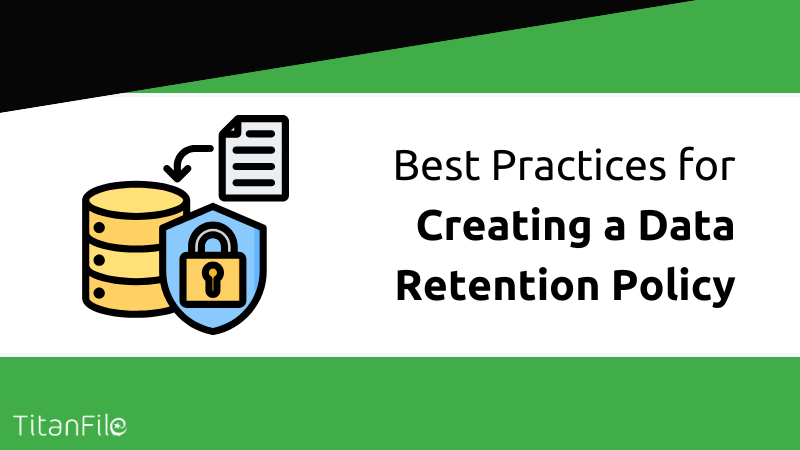In today’s data-driven world, managing and retaining business data is crucial for both legal compliance and efficient data management. But how can you stay ahead of the curve? This blog post will guide you through the data retention policy best practices for creating a policy that ensures compliance, reduces storage costs, and optimizes data management processes.
Key Takeaways
- Data retention is essential for legal compliance, data management optimization, storage cost reduction and breach prevention.
- Creating an effective policy involves researching applicable regulations, involving stakeholders and departments to define retention periods & disposal procedures.
- Regular audits/reviews of the policy should be conducted with employees trained on it while technology solutions such as archiving tools can help optimize processes.
Understanding Data Retention and Its Importance

Data retention is the practice of preserving and sustaining data for a predetermined period. The significance of data retention lies in adhering to legal requirements, optimizing data management, and reducing storage expenses.
A comprehensive data retention policy should include specifying the business rationales for preserving particular data, organizing information in a data retention policy, supervising long-term storage of business data, and regularly assessing the data retention policy. In this context, the term “data retention period refers” to the predetermined duration for which the data is to be preserved. To better understand this concept, one can look into data retention policy examples from various industries. By implementing a well-structured policy, companies can effectively retain data and ensure compliance with industry regulations.
Data retention programs are implemented for various reasons, including compliance, disaster recovery and providing data to analytical engines. These factors help determine the necessity of such programs. A well-thought-out data retention policy template should include legal obligations, business goals, and data categories, as well as retention periods and storage methods for different types of data. Bear in mind that data retention requirements are subject to variation by country and are outlined in a myriad of federal and state laws. Proper data retention policies can help prevent data breaches by ensuring that sensitive information is securely stored and disposed of when no longer needed.
Crafting a data retention policy doesn’t have a universal solution, as the applicable regulations can vary based on factors such as the organization’s size, its operational sector, and the nature of data it handles. However, some suggested procedures include:
- Specifying the business rationales for retaining data
- Organizing information in a data retention policy
- Supervising long-term storage of business data
- Regularly assessing the data retention policy
Key Factors to Consider in Data Retention Policy Development

Developing a comprehensive data retention policy involves considering key factors such as legal obligations, business goals, and data categories. It is important to take into account all data collected and obtained in the course of conducting business operations.
The upcoming subsections will explore in greater depth the factors of legal requirements, business objectives, and data types that merit consideration in the formulation of a data retention policy.
Legal Requirements and Industry Regulations
Legal requirements and industry regulations play a crucial role in shaping data retention policies and their respective retention periods. These requirements and regulations vary depending on the industry and location, making it essential for organizations to be well-versed with the regulations applicable to their specific circumstances.
For instance, the Health Insurance Portability and Accountability Act (HIPAA) mandates healthcare organizations in the United States to retain health information for a minimum of six years. Similarly, the Sarbanes-Oxley Act (SOX) requires publicly traded companies in the United States to maintain documents pertinent to auditing and review for a period of seven years.
Understanding and complying with these legal requirements and industry regulations not only helps organizations avoid penalties and legal consequences but also ensures the secure and efficient management of their data. Thus, keeping abreast of the most recent regulations and modifying your data retention policy as necessary is of paramount importance.
Business Needs and Objectives
Taking into account business needs and objectives is essential when determining data retention periods and storage methods. Some common business needs that can influence data retention policies include:
- Compliance with legal and regulatory requirements
- Financial record-keeping
- Litigation and legal proceedings
- Operational and business continuity
- Customer service and support
- Historical analysis and trend identification
- Data security and privacy
- Knowledge management and research
Collaboration between the IT team and legal departments is crucial when developing a data retention policy. For instance, the IT team should work closely with the legal department to:
- Define email retention schedules
- Determine the appropriate retention periods for different types of data
- Identify any legal or regulatory requirements that need to be considered
- Establish procedures for data disposal and destruction
This collaboration helps ensure that the data retention policy is comprehensive and well-informed, addressing the specific needs and requirements of the organization.
Data Types and Sensitivity Levels
When developing a data retention policy, giving due consideration to different data types and their sensitivity levels is of utmost importance. Different data types may require varying retention periods depending on their importance, confidentiality, and potential consequences in case of a breach or unauthorized transactions. For example, financial records, medical data, and personal information may have different retention periods based on their sensitivity and legal requirements.
Metadata can play a crucial role in managing data retention by helping determine when a data object is slated for deletion or assigned to a specific storage location. In addition, data classification and categorization can ensure that proper security measures are implemented based on the sensitivity levels of different types of data.
Steps to Creating an Effective Data Retention Policy

Creating an effective data retention policy involves a series of critical steps, including:
- Researching applicable regulations
- Involving stakeholders and key departments
- Defining retention periods
- Establishing procedures for data disposal
The subsequent subsections will delve into each of these steps in greater detail, providing guidance on crafting a data retention policy tailored to your organization’s unique needs and requirements.
1. Research and Understand Applicable Regulations
To ensure compliance and avoid penalties, it’s important to research and understand the applicable regulations that govern your organization’s data retention practices. For instance, the General Data Protection Regulation (GDPR) requires organizations to:
- Create a data retention policy that details precise timeframes for retaining data and the grounds for doing so.
- Implement measures to ensure that data is securely stored and protected during the retention period.
- Regularly review and update the data retention policy to ensure it remains in compliance with GDPR requirements.
Non-compliance with GDPR’s data retention requirements can result in severe penalties for organizations, including the risk of a data breach.
Being conversant with the specific legal and regulatory requirements pertinent to your industry and location enables the creation of a data retention policy that aligns with these guidelines and protects your organization from potential legal and financial repercussions. Keeping abreast of changing regulations and updating your data retention policy accordingly is crucial for maintaining compliance.
2. Involve Stakeholders and Key Departments
A comprehensive and well-informed data retention policy requires the involvement of stakeholders and key departments such as:
- Legal
- Accounting
- Department heads
- Internal stakeholders
This collaboration ensures that the policy addresses the unique needs and requirements of each department and the organization as a whole.
Accounting professionals, for example, can contribute to the development of data retention policies by:
- Identifying relevant financial and accounting records
- Ensuring compliance with regulatory regulations
- Providing input on retention periods
- Collaborating with other departments
Involving employees in data retention policy meetings also helps them gain a better understanding of the rationale behind various aspects of the policy and fosters a culture of compliance within the organization.
3. Define Retention Periods and Storage Methods
Defining retention periods and storage methods is a crucial aspect of an effective data retention policy. Retention periods can vary depending on the type of data and its sensitivity level, as well as legal requirements and industry regulations. ISO 27001 compliance framework is used by organizations. It requires them to save data logs for a minimum of 3 years. Establishing appropriate retention periods helps ensure efficient data management and compliance with legal requirements.
Beyond defining retention periods, setting up secure and efficient storage methods for your data is also crucial. This may involve utilizing data archiving and storage solutions like Amazon S3 and Amazon Glacier, which can help manage data efficiently and securely while complying with retention policies.
4. Establish Procedures for Data Disposal
Establishing procedures for data disposal is essential for ensuring secure and compliant data deletion. Implementing effective data disposal practices involves:
- Defining the data retention period precisely
- Constructing a data retention schedule that reflects the types of data your organization possesses
- Ensuring legal and regulatory compliance when disposing of data
- Using secure methods for data disposal, such as encryption or secure deletion
Regular audits and reviews of your data retention policy can help identify areas for improvement and ensure that your data disposal procedures remain effective and compliant. By implementing robust data disposal procedures, your organization can reduce the risk of data breaches and protect sensitive information from unauthorized access.
Monitoring and Updating Your Data Retention Policy
Monitoring and updating your data retention policy is crucial for its ongoing effectiveness and compliance. This involves conducting regular audits and reviews, updating the policy as needed, and training employees on data retention policy and procedures.
The subsequent subsections will examine each of these aspects in greater depth, assisting you in maintaining a robust and regulation-compliant data retention policy.
Conduct Regular Audits and Reviews
Performing regular audits and reviews of your data retention policy can help identify areas for improvement and ensure ongoing compliance with legal and regulatory requirements. It is generally advised that organizations review their data retention policy at least once a year to ensure that it remains current and abides by legal, regulatory, and contractual requirements.
Failing to conduct regular audits and reviews may result in:
- Increased chances of data breaches
- Posing risks to client data
- Non-compliance with regulatory guidelines
- Potential legal and financial consequences
- Retaining excessive amounts of data
By performing regular audits and reviews, your organization can proactively address potential issues and maintain an effective and compliant data retention policy.
Update Policies as Needed
Making necessary updates to your data retention policy is vital to ensure alignment with evolving regulations and business needs. Technological advancements, for instance, can introduce new data storage and management technologies, improve data analytics capabilities, create new security and privacy risks, and facilitate the integration of different data sources, which may impact your data retention practices.
It is essential to evaluate and update your data retention policy whenever there are modifications in compliance regulations, technology, or legal requirements that may affect data retention practices. By staying up-to-date with the latest developments and updating your policy accordingly, you can ensure that your organization remains compliant and effectively manages its data.
Train Employees on Data Retention Policy and Procedures
Educating employees about the data retention policy and its procedures is fundamental to ensure comprehension and compliance with the policy. This training should cover the key aspects of the data retention policy, including:
- Data classification
- Retention periods
- Data disposal procedures
- The importance of compliance with legal and regulatory requirements
Employee training on data retention policies should be conducted approximately two to three times annually, or roughly every four to six months. This ensures that employees remain informed about the latest developments in data retention practices and can effectively contribute to maintaining a compliant and secure data management environment.
Implementing Technology Solutions for Data Retention
To further enhance your data retention practices, implementing technology solutions such as data archiving, storage solutions, and automation tools can help streamline processes and reduce the risk of human error.
The subsequent subsections will explore the advantages of these technology solutions and their contribution to creating an effective and regulation-compliant data retention policy.
Data Archiving and Storage Solutions
Implementing data archiving and storage solutions can help your organization efficiently and securely manage data while complying with retention policies. For instance, you can use a secure file sharing platform like TitanFile which enables you to control when outdated or obsolete files are automatically deleted from the cloud.
Automation and Compliance Tools
Automation and compliance tools can significantly streamline data retention processes and reduce the risk of human error. By automating data retention tasks such as data classification, analysis, and disposal, these tools can help ensure that your organization’s data retention practices remain efficient and compliant with legal and regulatory requirements.
Examples of automation and compliance tools include:
- OneTrust
- Document Manager by Document Logistix
- Syncari
- Zapier
- Tray.io
- Workato
By leveraging these tools, your organization can effectively manage its data retention policies and maintain compliance with changing regulations.
Summary
In conclusion, creating and maintaining an effective data retention policy is crucial for ensuring legal compliance, efficient data management, and reducing storage costs. By considering key factors such as legal requirements, business objectives, and data types, and following the steps outlined in this blog post, your organization can develop a data retention policy that meets its unique needs and requirements.
In today’s rapidly evolving landscape, staying ahead of the curve in data retention best practices is essential for success. Implementing technology solutions, conducting regular audits and reviews, and updating policies as needed will ensure that your data retention policy remains compliant and effective in this ever-changing landscape.
Frequently Asked Questions
What is a good data retention policy?
A good data retention policy should define how long data should be retained, the format of stored records and data, the storage system used and any regulatory or legal requirements that need to be adhered to. It is important to research applicable laws before setting the retention period, as they may stipulate a specific length of time for which data must be kept.
What is the 7 year record retention rule?
The 7 year record retention rule states that tax returns should be kept for seven years, while other records such as I-9 forms or OSHA exposure records may require shorter or longer retention periods. Rule 2-06 also requires accounting firms to retain certain records for seven years, with the information kept confidential unless and until made public during a legal or administrative proceeding.
What are the components of a data retention policy?
A data retention policy outlines the purpose of collecting sensitive data, how it will be used and retained, which types do not need to be kept, and how it should be stored according to legal and regulatory requirements. It should also specify the length of time each type of data must be kept, who is responsible for managing it, and any backup plans.
How often should a data retention policy be audited and reviewed?
Data retention policies should be audited and reviewed at least once a year to maintain compliance with applicable laws, regulations, and contractual obligations.
What is the role of technology solutions in data retention?
Technology solutions play an integral role in data retention, helping to streamline processes, enable efficient data management, and reduce the risk of human error.

